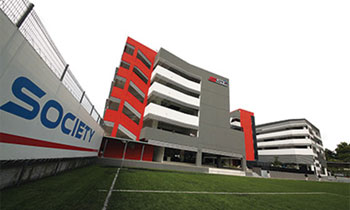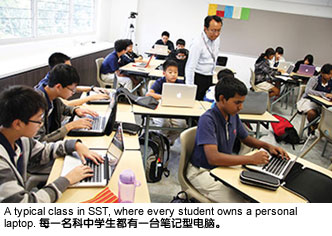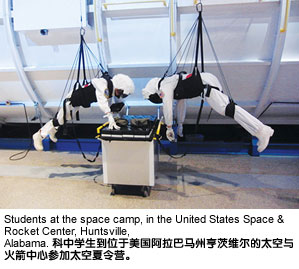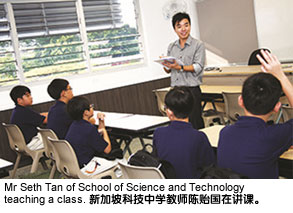 One of the biggest challenges in starting the School of Science and Technology (SST) was to convince parents that it was a viable option for their child.
One of the biggest challenges in starting the School of Science and Technology (SST) was to convince parents that it was a viable option for their child.
Parents were initially sceptical because learning was to be achieved via a combination of hands-on and theory application, and neither of these approaches was usual.
Said the School's founding principal, Mr Chua Chor Huat,"We only had words to justify our philosophy, our team and our methods. And no one believed us."
But three years on, the School is finding its students to have adapted well and who love their lessons and assignments.
"This has helped parents temper their initial prejudice," said Mr Chua.
The School was set up in 2009 by the Ministry of Education (MOE) with the purpose of providing students with more options for their secondary education. The stated aim was to provide a four-year curriculum leading to the O levels for students who possessed an aptitude for science and technology, together with an inclination to pursue innovative approaches to issues.
Mr Chua told EduNation that students not only imbibe knowledge in an engaging environment, but are also able to observe and better understand the world they live in through the applied learning approach. SST hopes to produce confident students who are well-versed in the sciences and technology through this approach.
FutureSchools@Singapore
SST joined MOE's FutureSchools@Singapore (FS@SG) Programme as soon as it started classes in 2010. At present, only eight schools in Singapore have been selected to participate in this Programme.
As part of the Programme SST collaborated with the National Institute of Education (NIE) in carrying out research into the development of innovative learning tools and new teaching strategies in the areas of languages, humanities, science and mathematics.
An example of the fruits of this collaboration, which also involved the Stanford Research Institute, is an application called Group Scribbles, which is an electronic post-it pad system facilitating discussions and active exchange of ideas.
Group Scribbles has a platform for both teachers and students. For the students it offers a private space as well as a shared space, and therefore when teachers invite students to express their opinions, they can scribble them on electronic post-its and post these on the shared space for everyone to read. Teachers and students can also exchange views on the platform, and rearrange or save their post-its for later.
 Learning from Application: Simultaneous Use of Hands and Brain Learning from Application: Simultaneous Use of Hands and Brain
Applied learning is an unconventional teaching method which requires simultaneous use of both the hands and the brain, and values the process as much as the result.
It is taught via relevant learning activities that bring together scientific theories and real-life applications, and it leads students to learn independently and proactively. The School collaborates with both industry and education partners like Nanyang Technological University (NTU) and Ngee Ann Polytechnic (NP), to bring about authentic and compelling learning experiences for its students.
What defines SST is its emphasis on innovative methods of teaching, in order to stimulate the students' interest in learning. For instance, its Secondary 2 students have no formal science lessons for a whole term -instead they use the time to come up with their own science projects.
"Students are provided with a good balance of freedom and support in planning and executing their projects. Experiments ranged from determining the positive attributes of traditional Chinese herbs to the development of a lightning detection facility. During this time, the teachers function as facilitators. This allows the students to explore the subject by themselves," said Mr Chua.
In their upper secondary years, students choose one of four applied subjects: biotechnology, media studies, the fundamentals of electronics or the newly-introduced design studies.
The curriculum design, teaching and assessment of these courses are handled by lecturers from NP. During lectures, teachers from SST are on hand to facilitate as well as provide assistance. Applied subjects are recognised as O level subjects and taken into consideration by both junior colleges and polytechnics for entry, and students who go on to study related disciplines in local polytechnics may be exempted from some modules.
Besides this collaboration with the polytechnics, SST also works with NTU to provide secondary students with an opportunity for an on-campus three-day, two-night learning camp. Students stay in NTU's hostels and work under the supervision of their lecturers on short projects.
Through these experiences at polytechnics and universities, Mr Chua hopes that his students will "pursue their passion in science and technology, and strengthen their understanding of key concepts."
Entrepreneurship Education
From Steve Jobs' Apple to Bill Gates' Microsoft empire, the development of technology requires entrepreneurship, a risk-taking mentality and the courage to attempt new approaches.
Hence, SST introduced the Innovation and Entrepreneurship (I & E) programme and became the first secondary school to offer innovation and entrepreneurship as a subject.
"We encourage students to talk about entrepreneurship not because we want them to become businessmen or entrepreneurs but because we want to imbue them with an entrepreneurial spirit - the entrepreneur's spirit of innovation is more important than actually becoming one. We want our students to be unafraid of problems, and instead see them as opportunities to improve," said Mr Chua.
The School arranges for entrepreneurs to give talks and encourage its students to conceptualise business ideas which culminate in an entrepreneurship fair, where students sell their goods. In addition, the School has an Entrepreneurship Advisory Council (EAC) to provide suggestions for the I & E Programme.
The School's Secondary 1 students now participate in NP's two-day entrepreneurship course where they can pick up fundamental business and marketing skills from the course lecturers as well as the Year 3 polytechnic students. In the two days, students learn things ranging from product production techniques to perfecting the one-minute elevator sales pitch.
"The School organises these activities to develop students' interest in entrepreneurship, and they come up with many interesting ideas which often surprise us," said Mr Chua.
As the students are too young to enter the workforce and experience first-hand entrepreneurial concepts and theories, SST is working with Action Community for Entrepreneurship (ACE)'s newly set up Education Entrepreneurship Task Force to look into how they can implement entrepreneur education with organisations in a systematic manner - something which is currently only available at tertiary level.
Connecting with the World
SST's mission is to develop world-ready and future-looking leaders through innovative technology and applied learning. Hence, the School arranges for its students to take part in global exchanges in order to cultivate a global mindset.
The School's first-year students have visited Hanoi and Ho Chi Minh City in Vietnam, while the Secondary 2s and 3s have been to Malaysia, Nepal and the United States. In Hawaii, they visited President Barack Obama's alma mater, Punahou School, which has successfully harnessed the use of science and technology in its curriculum. And in Huntsville, Alabama, they took part in a space camp at the United States Space & Rocket Center.
"We want our students to venture overseas - not to be tourists but to observe their peers' learning journeys in other countries and reflect on their own learning. In addition, they should also develop a stronger awareness of Singapore's role within the Asia-Pacific region and the world at large," said Mr Chua.
The School also believes in adopting a balanced and holistic approach to nurturing its students; it therefore places a premium on character development and requires its students carry out service learning projects both at home and abroad.
 Under the School's Global Citizenship Programme students learn how to plan and execute meaningful overseas projects themselves. A recent example of such an initiative saw a group of SST students staying in a village in Cambodia where they taught basic English, did some house painting and learnt about the country's history and culture in the process. Under the School's Global Citizenship Programme students learn how to plan and execute meaningful overseas projects themselves. A recent example of such an initiative saw a group of SST students staying in a village in Cambodia where they taught basic English, did some house painting and learnt about the country's history and culture in the process.
Projects like this are intended to help students re-assess their own dispositions and values, and realise that they should not take what they have for granted. As a result, the hope is that they will continue to help the less fortunate after their projects have ended.
And there is already evidence of this. "After participating in these community service projects, students often reflect and come up with new ideas to help the less fortunate," said Mr Chua.
Student Selection
Those who are interested in applying to SST will be required to sit for a General Ability Test (GAT) and attend a selection camp. The school handpicks each student through the Direct School Admissions Scheme (DSA).
During the camp, teachers observe the shortlisted students to see if they would be a good fit for the School's curriculum. Qualities such as potential, teamwork and co-operation are vital to their adaptability in SST. According to past records, the School's first three cohorts posted an average aggregate score of 240 points for Primary School Leaving Examination (PSLE).
"Future economic trends will depend not solely on a single model. We need talented individuals in different areas, from different sectors. The set-up of SST builds the foundation for the diversification of talent in Singapore. It is good not only for the country but for our students as well," noted Mr Chua.
Teachers Not Deployed by MOE
 SST's focus on innovative teaching methods means its teachers must be very open to exploring alternative methods of teaching and to using technology to ignite the students' interest for learning. SST's focus on innovative teaching methods means its teachers must be very open to exploring alternative methods of teaching and to using technology to ignite the students' interest for learning.
The School's teachers are therefore not deployed by MOE. Instead, SST advertises and appoints them directly.
"We ask that teachers be willing to let go of the more conventional ways of teaching and be prepared to come up with engaging methods if they want to join our team. In addition, teachers must have a certain level of content knowledge and must be open-minded. Lastly, we insist on them having had at least three years' teaching experience before they come to us," said Mr Chua.
Future Plans
Since SST was started, there has been such positive feedback that it has led to speculation over whether the four-year secondary education could be extended to a six-year through-train programme. This is apt considering that the School's approach to applied learning and creative teaching seems naturally to lead to tertiary education.
Mr Chua said that the priority at hand was to fulfil the School's mandate in providing a diversified learning pathway for talented youths on the four-year curriculum track to the O levels. On whether the School will extend its path into a six-year curriculum, he was cautious, but did not rule out the possibility.
"When we decided to have a four-year curriculum, we wanted to give students more choices for their secondary education. Now, more schools are starting through-train programmes and coming up with different features and focus. Before we make any concrete decisions, we need to find the meaning behind a six-year curriculum and the value it adds for our students and the country. It is still something we are reviewing," concluded Mr Chua.
|